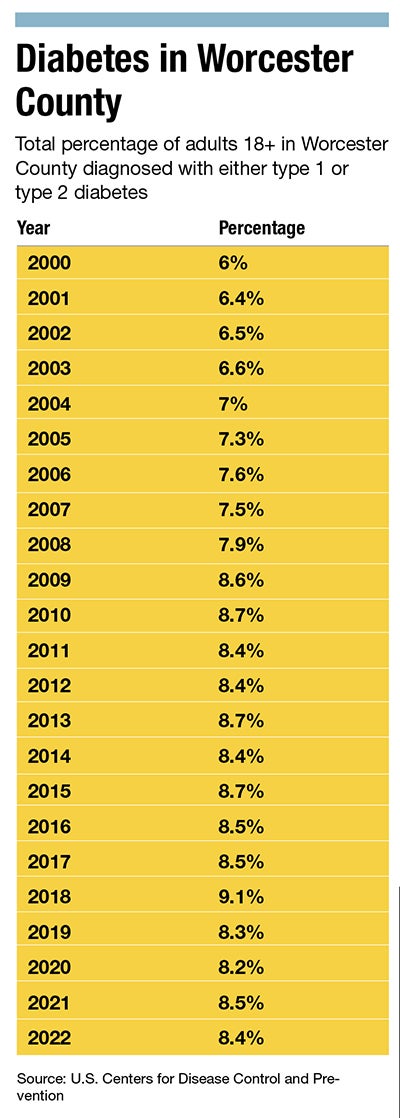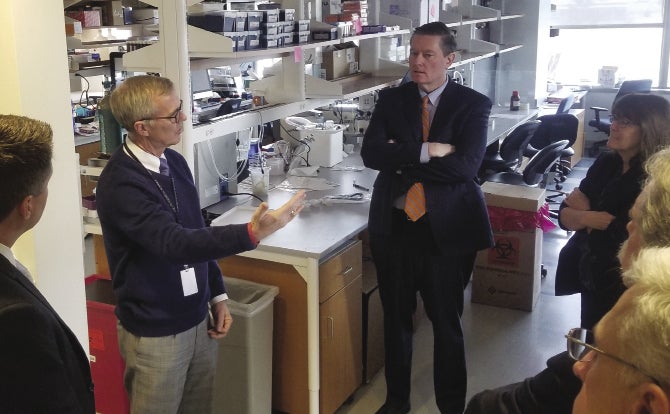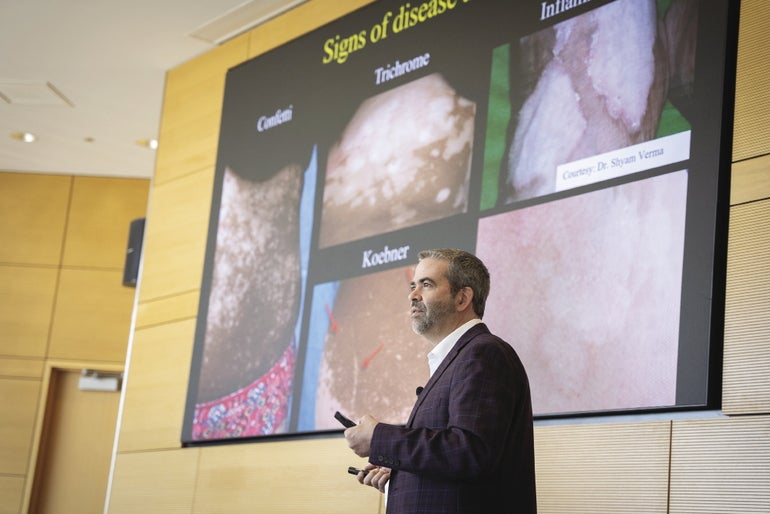Now professor and chair of the Department of Dermatology at UMass Chan, Harris has founded a vitiligo pharmaceutical company and is about to launch a 1,000-person vitiligo study.
Get Instant Access to This Article
Subscribe to Worcester Business Journal and get immediate access to all of our subscriber-only content and much more.
- Critical Central Massachusetts business news updated daily.
- Immediate access to all subscriber-only content on our website.
- Bi-weekly print or digital editions of our award-winning publication.
- Special bonus issues like the WBJ Book of Lists.
- Exclusive ticket prize draws for our in-person events.
Click here to purchase a paywall bypass link for this article.
Dr. John Harris hadn’t originally realized his two professional desires – to work with autoimmunity and to work with people – would be at odds when he first delved into type 1 diabetes research.
When developing his PhD thesis, Harris had selected a lab focusing its studies on type 1 diabetes, but he quickly became frustrated with the fact he was working with mice and cells in dishes instead of being face to face with patients.
To rectify this issue, Harris, switched to the field of dermatology to research and treat the autoimmune disease vitiligo. This transition didn’t mean he had abandoned hope for treating type 1 diabetes. In fact, the reality was quite the opposite.
Now professor and chair of the Department of Dermatology at UMass Chan Medical School in Worcester and founding director of the school’s Vitiligo Clinic and Research Center, Harris has founded a vitiligo pharmaceutical company and is about to launch a 1,000-person vitiligo study, both of which have strong ties and promising potential for type 1 diabetes prevention.

Studying one disease to treat another
Back in medical school after defending his thesis, Harris was asked to perform a physical exam on a patient with new-onset type 1 diabetes who was recovering from ketoacidosis, a complication of diabetes. In doing so, he noticed the patient had a large white spot on her back and immediately recognized it as vitiligo. The white spot had formed at the same time as the onset of the patient’s diabetes, and Harris would go on to discover this patient had four autoimmune disorders which came on at once: type 1 diabetes, vitiligo, Hashimoto's thyroiditis, and pernicious anemia.
“I recognized that one of [the disorders] was in the skin, and I had access to that. I said ‘If I study vitiligo I can understand what causes autoimmunity without having to get to the pancreas,’” Harris said.
With type 1 diabetes, the immune system attacks the body’s insulin-making cells. Type 1 diabetics account for about 5% to 10% of all diabetes cases, totalling in about 2 million Americans in 2021, according to the Centers for Disease Control and Prevention. On the other hand, the more prevalent type 2 diabetes is not an autoimmune condition, and instead, is an issue with how the body regulates insulin.
Between 2002 and 2015, new incidence of type 1 diabetes increased 1.9% per year, according to the CDC. Rates appear to be increasing as more recently. The total number of Americans with type 1 diabetes rose nearly 30% from 1.25 million in 2017 to nearly 1.6 million in 2020, according to an analysis by the Juvenile Diabetes Research Foundation (JDRF) Center of Excellence in New England of the CDC’S 2020 National Diabetes Statistics Report.

Within that same 2002 to 2015 timeframe, rates of type 1 diabetes increased most evidently in Black and Hispanic youth with cases rising nearly 20% as opposed to white youth whose cases increased 14%, according to the CDC. The reasons for the overall rise in type 1 diabetes cases and the racial disparities within those numbers are unknown.
Though rates of type 1 diabetes are on the rise throughout the country and world, Massachusetts Environmental Public Health Tracking records show no statistically significant difference exists in the numbers of students with type 1 diabetes in Worcester County from the 2009-2010 school year through the 2022-2023 school year. Rates have toggled between 2.5 and 2.6 cases per 1,000 students amongst those years with the 2022-2023 school year including 201 students with type 1 diabetes out of the total 82,751 students.
“When you look at the genes involved in all these different autoimmune diseases, there’s a lot of overlap where the genes that cause type 1 diabetes are the same genes that cause vitiligo and a number of other autoimmune diseases,” said Harris.
$4M to find biomarkers
In the case of vitiligo, the immune system uses what are called T cells to attack melanocytes, the cells responsible for creating melanin that give the skin color, creating white spots where there was once pigmented skin. According to the Vitiligo Clinic and Research Center, vitiligo affects 0.5-2% of the population.
In 2019, Harris founded Villaris Therapeutics (one of five pharmaceutical companies he’s launched to treat autoimmune and inflammatory diseases) to make a drug blocking a protein called IL-15, a protein he and his team found was vital to vitiligo. The company, based in North Carolina, was acquired a little over a year ago by Delaware biopharmaceutical company Incyte, the same company that owns the only vitiligo treatment approved by the U.S. Food & Drug Administration. Unlike that treatment, Harris believes once patients stop taking the Villaris drug, patients’ vitiligo won’t come back
Though the drug was created for vitiligo treatment, Harris said a study performed on mice showed if a drug blocks IL-15, it could prevent type 1 diabetes.
Harris is now working toward discovering a prevention for vitiligo. Eight months ago, his team at UMass Chan responded to a call from the National Institutes of Health looking for researchers who thought they could discover markers of those patients who don’t currently have, but will develop, autoimmunity.
They received a $4-million grant. The team is now in the process of recruiting 200 individuals with vitiligo and 800 of their family members for the study. Harris and his team will follow participants over several years, examining samples of their skin and blood, looking for signals indicating who is going to get vitiligo before they do, so they can ultimately work to block those signals.
“If we see a biomarker that predicts somebody getting vitiligo, we think that could be a shared biomarker to someone who is going to get diabetes … The reason we’re doing it in vitiligo is vitiligo is much more common than diabetes, and there’s a high risk to relatives of people with vitiligo, and we have access to the skin,” said Harris.
This exact issue of access, which originally prompted Harris’ transition to dermatology, is one of the most challenging hurdles in diabetes research, said Dr. David Harlan, co-director of the UMass Diabetes Center of Excellence and director of Juvenile Diabetes Research Foundation (JDRF) Center of Excellence in New England.

Harlan’s research centers beta cell biology and the anti-beta cell immune response indicative of type 1 diabetes. Both Harlan and Harris work to find the cause of their respective autoimmune diseases of choice in order to then be able to develop effective treatments, if not preventions. In that search for a cause, researchers have found the finger might be pointing in the wrong direction in the search for the source of the problem, Harlan said.
“What we don’t know is what triggers that immune process to begin with … There is data to suggest that something’s wrong with the beta cells, then that immune response gets out of hand and doesn’t shut off. So there is an immune component, but the beta cell may not be a passive victim, it may have instigated its own killing,” Harlan said.
What this means, said Harlan, is a possibility something abnormal about the beta cells themselves are causing the immune system to attack them.
Harlan's team at JDRF New England Center is working to identify a drug to ultimately prevent those beta cells from being destroyed, which could prevent the disease altogether.
“I always tell people, ‘I hope I live long enough to say I remember when there used to be a disease called type 1 diabetes, but we can prevent it now with a pill.’” Harlan said.

